实验7:基于REST API的SDN北向应用实践
实验7:基于REST API的SDN北向应用实践
一、实验目的
- 能够编写程序调用OpenDaylight REST API实现特定网络功能;
- 能够编写程序调用Ryu REST API实现特定网络功能。
二、实验环境
- 下载虚拟机软件Oracle VisualBox或VMware;
- 在虚拟机中安装Ubuntu 20.04 Desktop amd64,并完整安装Mininet、OpenDaylight(Carbon版本)、Postman和Ryu;
三、实验要求
(一)基本要求
- OpenDaylight
(1) 利用Mininet平台搭建下图所示网络拓扑,并连接OpenDaylight;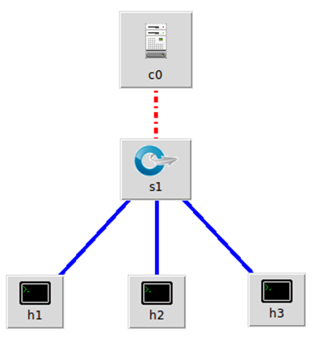
- 先打开ODL控制器
./distribution-karaf-0.6.4-Carbon/bin/karaf - 创建拓扑
sudo mn --topo=single,3 --controller=remote,ip=127.0.0.1,port=6633 --switch ovsk,protocols=OpenFlow13
(2) 编写Python程序,调用OpenDaylight的北向接口下发指令删除s1上的流表数据。
55delete.py
#!/usr/bin/python import requests from requests.auth import HTTPBasicAuth if __name__ == "__main__": url = 'http://127.0.0.1:8181/restconf/config/opendaylight-inventory:nodes/node/openflow:1/' headers = {'Content-Type': 'application/json'} res = requests.delete(url, headers=headers, auth=HTTPBasicAuth('admin', 'admin')) print (res.content)
(3) 编写Python程序,调用OpenDaylight的北向接口下发硬超时流表,实现拓扑内主机h1和h3网络中断20s。
保存为55put.py
#!/usr/bin/python import requests from requests.auth import HTTPBasicAuth if __name__ == "__main__": url = 'http://127.0.0.1:8181/restconf/config/opendaylight-inventory:nodes/node/openflow:1/flow-node-inventory:table/0/flow/1' with open("./flowtimeout.json") as file: str = file.read() headers = {'Content-Type': 'application/json'} res = requests.put(url, str, headers=headers, auth=HTTPBasicAuth('admin', 'admin')) print (res.content)
保存为flowtimeout.json
{ "flow": [ { "id": "1", "match": { "in-port": "1", "ethernet-match": { "ethernet-type": { "type": "0x0800" } }, "ipv4-destination": "10.0.0.3/32" }, "instructions": { "instruction": [ { "order": "0", "apply-actions": { "action": [ { "order": "0", "drop-action": {} } ] } } ] }, "flow-name": "flow", "priority": "65535", "hard-timeout": "20", "cookie": "2", "table_id": "0" } ] }
- (2)(3)运行结果
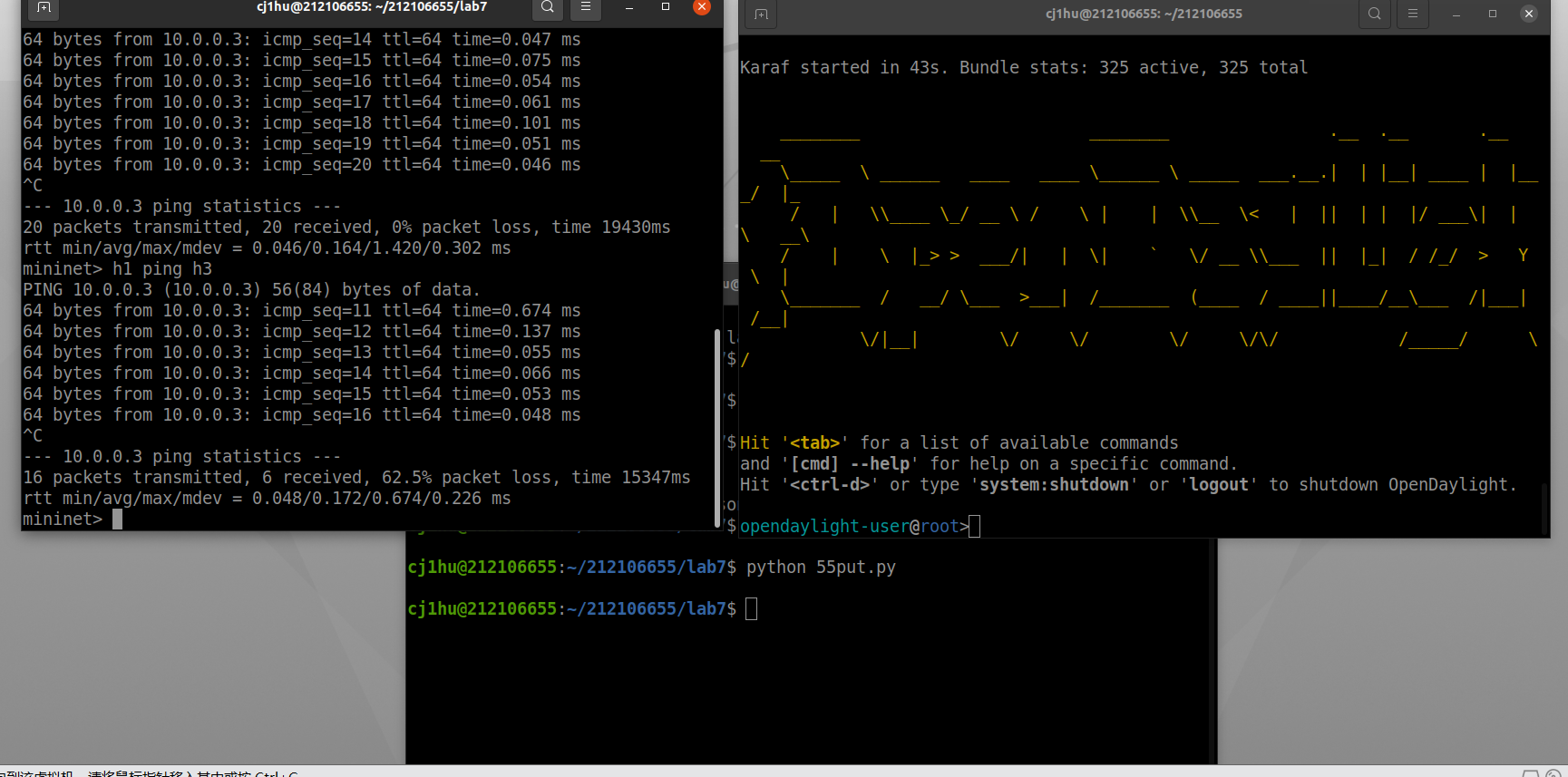
(4) 编写Python程序,调用OpenDaylight的北向接口获取s1上活动的流表数。
保存为55get.py
#!/usr/bin/python import requests from requests.auth import HTTPBasicAuth if __name__ == "__main__": url = 'http://127.0.0.1:8181/restconf/operational/opendaylight-inventory:nodes/node/openflow:1/flow-node-inventory:table/0/opendaylight-flow-table-statistics:flow-table-statistics' headers = {'Content-Type': 'application/json'} res = requests.get(url,headers=headers, auth=HTTPBasicAuth('admin', 'admin')) print (res.content)
- 运行结果

- Ryu
(1) 编写Python程序,调用Ryu的北向接口,实现上述OpenDaylight实验拓扑上相同的硬超时流表下发。
保存为55Ryuput.py
#!/usr/bin/python import requests if __name__ == "__main__": url = 'http://127.0.0.1:8080/stats/flowentry/add' with open("./Ryutimeout.json") as file: str = file.read() headers = {'Content-Type': 'application/json'} res = requests.post(url, str, headers=headers) print (res.content)
保存为Ryutimeout.json
{ "dpid": 1, "cookie": 1, "cookie_mask": 1, "table_id": 0, "hard_timeout": 20, "priority": 65535, "flags": 1, "match":{ "in_port":1 }, "actions":[ ] }
- 先打开Ryu控制器
ryu-manager ryu.app.simple_switch_13 ryu.app.ofctl_rest - 创建拓扑
sudo mn --topo=single,3 --controller=remote,ip=127.0.0.1,port=6633 --switch ovsk,protocols=OpenFlow13 - 运行结果
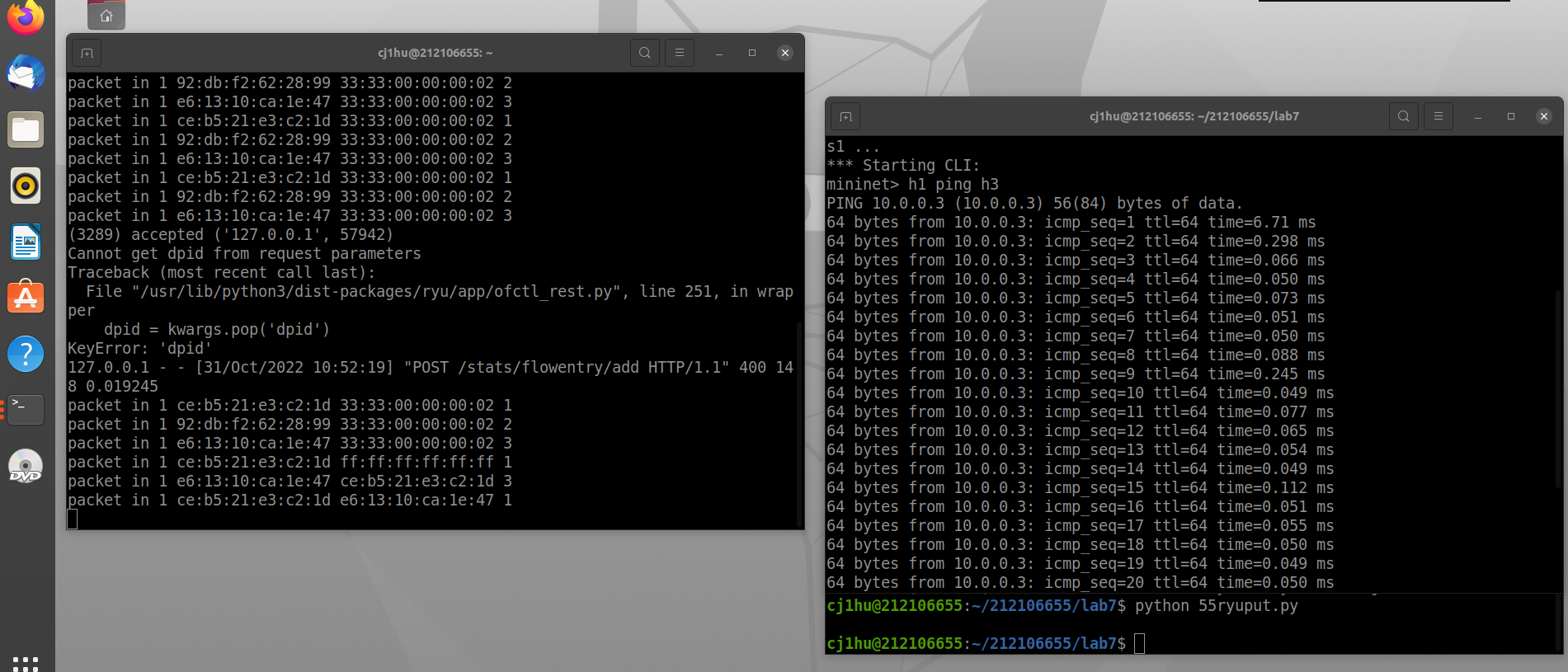
(2) 利用Mininet平台搭建下图所示网络拓扑,要求支持OpenFlow 1.3协议,主机名、交换机名以及端口对应正确。拓扑生成后需连接Ryu,且Ryu应能够提供REST API服务。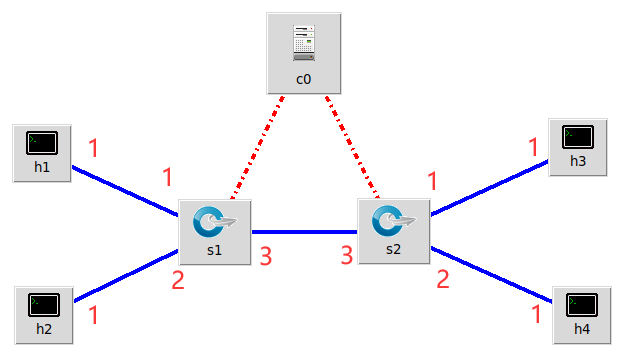
- 代码
保存为topo.py
from mininet.topo import Topo class MyTopo(Topo): def __init__(self): # initilaize topology Topo.__init__(self) self.addSwitch("s1") self.addSwitch("s2") self.addHost("h1") self.addHost("h2") self.addHost("h3") self.addHost("h4") self.addLink("s1", "h1") self.addLink("s1", "h2") self.addLink("s2", "h3") self.addLink("s2", "h4") self.addLink("s1", "s2") topos = {'mytopo': (lambda: MyTopo())}
- 先打开Ryu控制器
ryu-manager ryu.app.simple_switch_13 ryu.app.ofctl_rest - 命令行输入
sudo sudo mn --custom topo.py --topo mytopo --mac --controller=remote,ip=127.0.0.1,port=6633 --switch ovsk,protocols=OpenFlow13创建题目要求的拓扑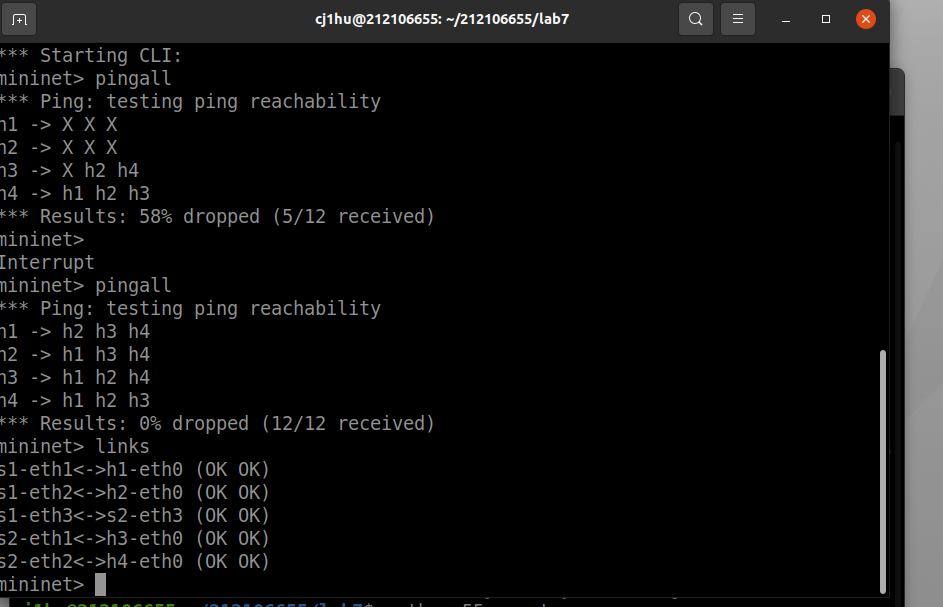

- 先删除流表,命令行输入:
curl -X DELETE http://127.0.0.1:8080/stats/flowentry/clear/1curl -X DELETE http://127.0.0.1:8080/stats/flowentry/clear/2 - 运行v1.sh脚本
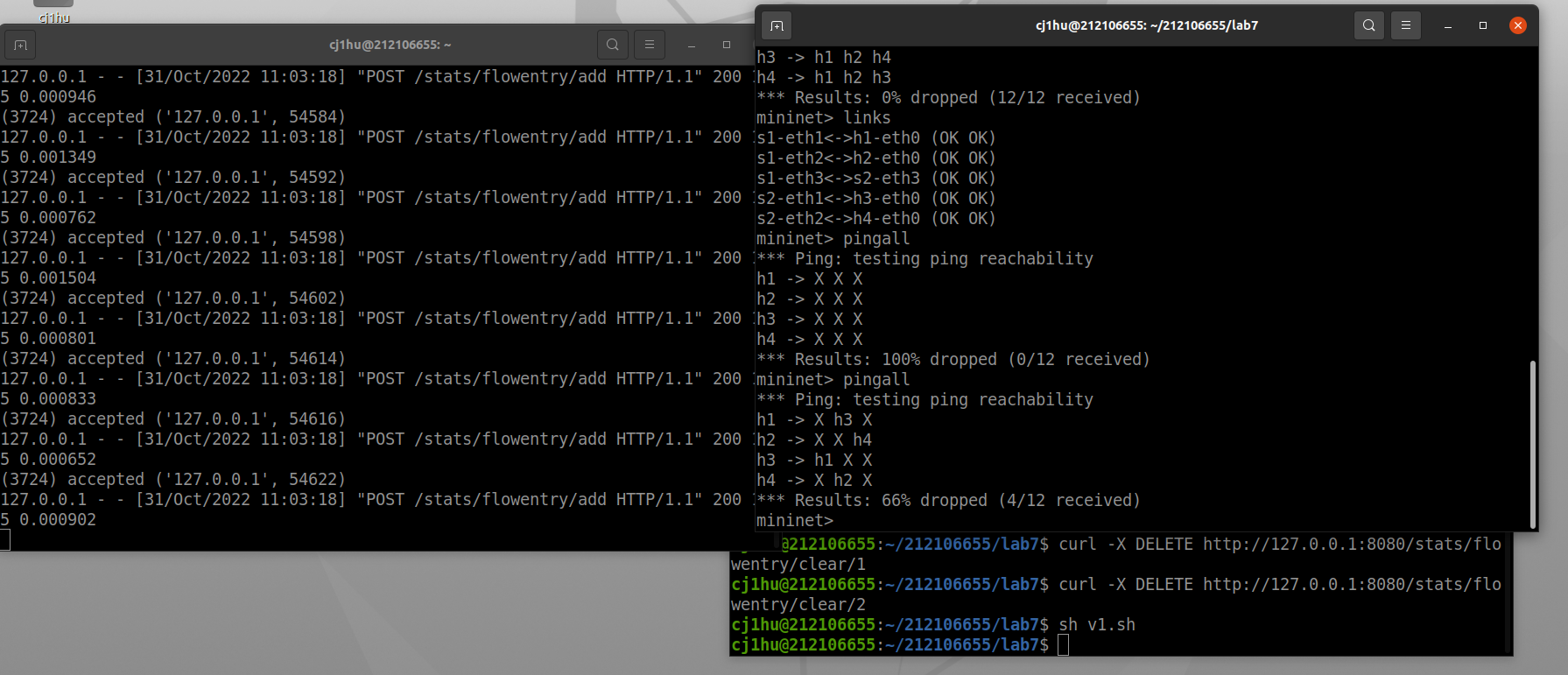
编程实现基本要求第2部分Ryu(3)中的VLAN划分。
- 代码
保存为55vlan.py
#!/usr/bin/python import json import requests if __name__ == "__main__": url = 'http://127.0.0.1:8080/stats/flowentry/add' headers = {'Content-Type': 'application/json'} flow1 = { "dpid": 1, "priority": 1, "match":{ "in_port": 1 }, "actions":[ { "type": "PUSH_VLAN", "ethertype": 33024 }, { "type": "SET_FIELD", "field": "vlan_vid", "value": 4096 }, { "type": "OUTPUT", "port": 3 } ] } flow2 = { "dpid": 1, "priority": 1, "match":{ "in_port": 2 }, "actions":[ { "type": "PUSH_VLAN", "ethertype": 33024 }, { "type": "SET_FIELD", "field": "vlan_vid", "value": 4097 }, { "type": "OUTPUT", "port": 3 } ] } flow3 = { "dpid": 1, "priority": 1, "match":{ "vlan_vid": 0 }, "actions":[ { "type": "POP_VLAN", "ethertype": 33024 }, { "type": "OUTPUT", "port": 1 } ] } flow4 = { "dpid": 1, "priority": 1, "match": { "vlan_vid": 1 }, "actions": [ { "type": "POP_VLAN", "ethertype": 33024 }, { "type": "OUTPUT", "port": 2 } ] } flow5 = { "dpid": 2, "priority": 1, "match": { "in_port": 1 }, "actions": [ { "type": "PUSH_VLAN", "ethertype": 33024 }, { "type": "SET_FIELD", "field": "vlan_vid", "value": 4096 }, { "type": "OUTPUT", "port": 3 } ] } flow6 = { "dpid": 2, "priority": 1, "match": { "in_port": 2 }, "actions": [ { "type": "PUSH_VLAN", "ethertype": 33024 }, { "type": "SET_FIELD", "field": "vlan_vid", "value": 4097 }, { "type": "OUTPUT", "port": 3 } ] } flow7 = { "dpid": 2, "priority": 1, "match": { "vlan_vid": 0 }, "actions": [ { "type": "POP_VLAN", "ethertype": 33024 }, { "type": "OUTPUT", "port": 1 } ] } flow8 = { "dpid": 2, "priority": 1, "match": { "vlan_vid": 1 }, "actions": [ { "type": "POP_VLAN", "ethertype": 33024 }, { "type": "OUTPUT", "port": 2 } ] } res1 = requests.post(url, json.dumps(flow1), headers=headers) res2 = requests.post(url, json.dumps(flow2), headers=headers) res3 = requests.post(url, json.dumps(flow3), headers=headers) res4 = requests.post(url, json.dumps(flow4), headers=headers) res5 = requests.post(url, json.dumps(flow5), headers=headers) res6 = requests.post(url, json.dumps(flow6), headers=headers) res7 = requests.post(url, json.dumps(flow7), headers=headers) res8 = requests.post(url, json.dumps(flow8), headers=headers)
(三)实验心得
- 无法ping通 解决方法:无论是连接哪种控制器,都应该先开控制器再创建拓扑
- 在划分VLAN的时候一直无法成功
- 解决方法:先利用curl命令删除流表
- 每次创建新拓扑前都要用
sudo mn -c
- 删除旧拓扑

